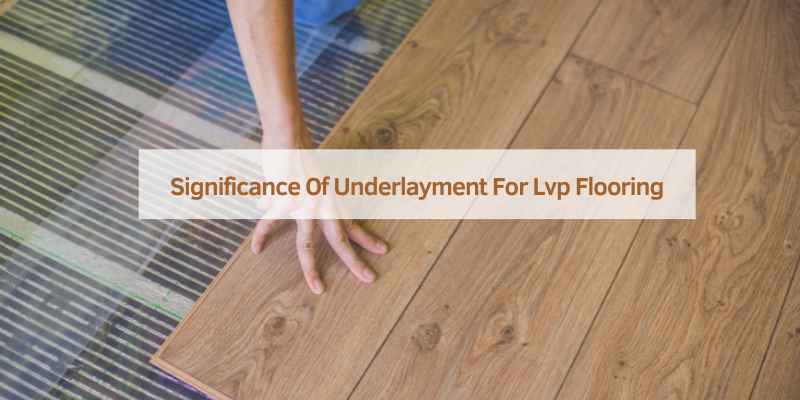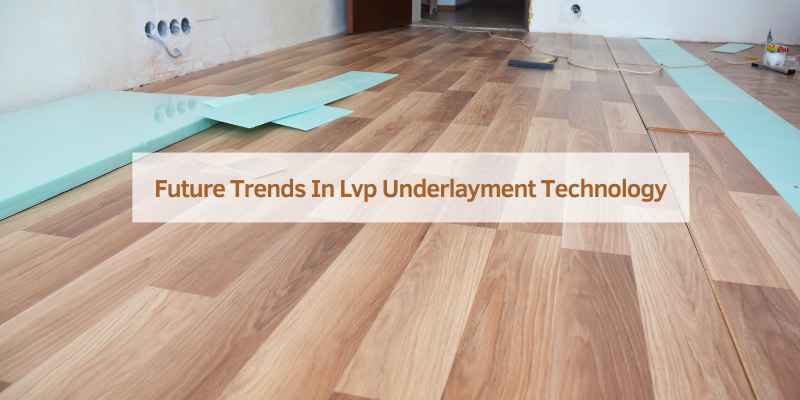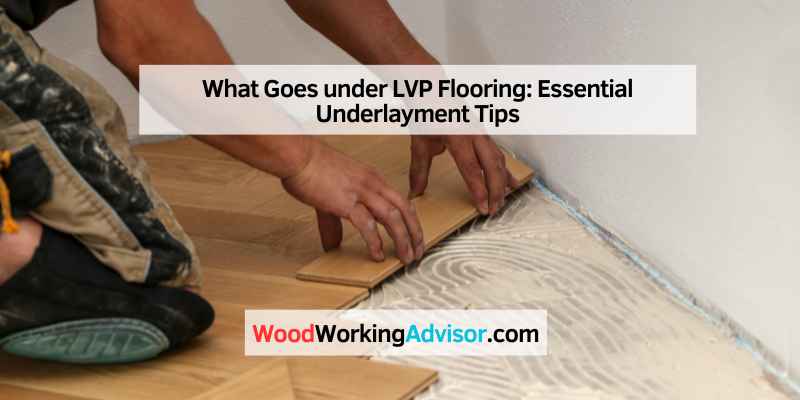Underlayment, moisture barrier, and subfloor preparation go under LVP flooring. These elements ensure stability, insulation, and moisture protection.
LVP flooring, or luxury vinyl plank, requires proper preparation for optimal performance. A suitable underlayment provides cushioning and soundproofing, enhancing comfort underfoot. A moisture barrier is crucial to prevent water damage, especially in areas prone to dampness. The subfloor must be clean, dry, and level to avoid imperfections that could affect the flooring’s longevity.
Proper preparation not only enhances durability but also ensures a smooth and professional finish. Investing time in these steps will result in a beautiful and long-lasting LVP floor that adds value and aesthetic appeal to any space.
Significance Of Underlayment For Lvp Flooring
Luxury Vinyl Plank (LVP) flooring has become popular for its durability and aesthetic appeal. But, one crucial aspect often overlooked is the significance of underlayment for LVP flooring. Underlayment is a thin layer of material placed beneath the LVP flooring. It provides support, cushioning, and other benefits that enhance the overall performance of your floor.
Benefits Of Proper Underlayment
Using the right underlayment can make a significant difference in your flooring experience.
- Sound Reduction: A good underlayment helps reduce noise, making your home quieter.
- Moisture Barrier: It acts as a barrier against moisture, protecting your LVP flooring from damage.
- Improved Comfort: It adds a layer of cushioning, making your floors more comfortable to walk on.
- Enhanced Insulation: Underlayment provides thermal insulation, keeping your home warmer in winter and cooler in summer.
Impact On Flooring Longevity
Proper underlayment not only enhances comfort and performance but also impacts the longevity of your LVP flooring.
Prevents Wear and Tear: Underlayment absorbs the impact of foot traffic, reducing wear and tear on the flooring.
Maintains Floor Stability: It helps maintain floor stability, preventing the planks from shifting and creating gaps over time.
Reduces Subfloor Imperfections: Underlayment smooths out minor imperfections in the subfloor, providing a more even surface for the LVP flooring.
Extends Warranty: Many LVP flooring warranties require proper underlayment. It ensures that you get the most out of your investment.
Investing in the right underlayment is a small step that delivers significant benefits, ensuring your LVP flooring looks and performs its best for years to come.

Types Of Underlayment Suitable For Lvp
Choosing the right underlayment for Luxury Vinyl Plank (LVP) flooring is vital. The underlayment provides cushioning, soundproofing, and moisture protection. Below are some of the best underlayment options for LVP flooring.
Foam Underlayment Options
Foam underlayment is popular for its ease of installation and affordability. It provides a soft cushion underfoot and helps reduce noise. Foam underlayment comes in different thicknesses to suit various needs.
- Standard Foam – This is a basic option. It offers decent cushioning and sound absorption.
- Combination Foam – This type includes a moisture barrier. It’s ideal for areas prone to dampness.
- High-Density Foam – Provides better support and durability. Suitable for high-traffic areas.
Cork As An Eco-friendly Choice
Cork underlayment is an excellent eco-friendly option. It is made from natural cork, making it sustainable and biodegradable. Cork is known for its superior sound insulation properties.
| Feature | Cork Underlayment |
|---|---|
| Material | Natural Cork |
| Soundproofing | High |
| Eco-Friendliness | Excellent |
| Durability | Good |
Cork is also naturally resistant to mold and mildew. It provides a comfortable, warm surface underfoot, making it a great choice for homes.
Underlayment Thickness And Lvp Performance
Luxury Vinyl Plank (LVP) flooring is popular for its durability and style. Yet, the right underlayment plays a crucial role in its performance. Underlayment thickness can impact comfort, insulation, and stability. Choosing the correct underlayment ensures your LVP flooring performs at its best.
Ideal Thickness For Comfort And Insulation
The thickness of the underlayment affects the comfort underfoot. A thicker underlayment provides a softer feel when walking. It can also help with insulation, keeping the floor warm in winter and cool in summer.
For most LVP flooring, an underlayment thickness of 2mm to 3mm is ideal. This range offers a balance between comfort and insulation without compromising the floor’s integrity. Thicker underlayment can also reduce noise, making it a great choice for multi-level homes.
Balancing Thickness With Floor Stability
While thicker underlayment offers comfort, it is essential to ensure floor stability. An underlayment that is too thick can cause the floor to feel spongy. This can lead to issues with the flooring over time.
A 2mm to 3mm underlayment provides the right balance. It ensures the floor remains stable while offering the benefits of comfort and insulation. Always consult the LVP manufacturer’s guidelines for the recommended underlayment thickness.
| Underlayment Thickness | Comfort Level | Insulation | Stability |
|---|---|---|---|
| 1mm | Low | Low | High |
| 2mm | Medium | Medium | High |
| 3mm | High | High | Medium |
| 4mm+ | Very High | Very High | Low |
Choosing the right underlayment thickness is key to your LVP flooring’s performance. Aim for a balance of comfort, insulation, and stability.
Acoustic Properties Of Lvp Underlayment
Luxury Vinyl Plank (LVP) flooring is popular for its durability and stylish appearance. But the right underlayment can greatly enhance its acoustic properties. Proper underlayment reduces noise and adds comfort underfoot. This section explores how to choose the best underlayment for sound control.
Reducing Noise With The Right Underlayment
Reducing noise in your living space is crucial for comfort. LVP underlayment can help achieve this by absorbing sound. This prevents noise from echoing through rooms. The right underlayment can make a significant difference.
There are different types of underlayments available. Some are designed specifically for sound reduction. These include materials like foam, cork, and rubber. Each material has its unique properties that help in noise reduction.
Foam underlayment is lightweight and easy to install. Cork is a natural material that provides excellent sound absorption. Rubber underlayment is durable and offers superior noise reduction. Choosing the right material depends on your specific needs and budget.
Sound Ratings To Consider
When selecting underlayment for LVP flooring, look at the sound ratings. These ratings indicate how well the underlayment can reduce noise. The two main ratings to consider are STC (Sound Transmission Class) and IIC (Impact Insulation Class).
| Rating | Description |
|---|---|
| STC | Measures the ability to block airborne sounds. |
| IIC | Measures the ability to reduce impact noise, like footsteps. |
An underlayment with a high STC rating will block more airborne noise. This includes sounds like voices and music. An underlayment with a high IIC rating will reduce impact noises. This includes sounds from walking or moving furniture.
Here is a quick guide to choose the right underlayment based on sound ratings:
- For high traffic areas, choose an underlayment with high IIC rating.
- For rooms where privacy is important, focus on high STC rating.
- Consider a balanced underlayment for general use.
By understanding these ratings, you can make an informed decision. This ensures your LVP flooring not only looks good but also feels quiet and comfortable.
Moisture Barrier Considerations
Installing luxury vinyl plank (LVP) flooring requires careful planning. One key factor is the moisture barrier. This is crucial for protecting your new flooring from water damage.
Importance Of Moisture Protection
Moisture can damage LVP flooring over time. Water can seep through the subfloor, causing the planks to warp or buckle. A moisture barrier helps prevent this. It keeps the subfloor dry and extends the life of your flooring.
Moisture protection is especially important in areas like basements and bathrooms. These places are prone to high humidity levels. A moisture barrier acts as a shield, safeguarding your LVP flooring from potential water damage.
Integrated Vs. Separate Moisture Barriers
There are two main types of moisture barriers: integrated and separate. Each type has its own set of advantages and disadvantages.
| Type | Advantages | Disadvantages |
|---|---|---|
| Integrated |
|
|
| Separate |
|
|
Integrated moisture barriers come pre-attached to the LVP planks. This option saves time and effort during installation. But, they might not be as effective as separate barriers.
Separate moisture barriers are installed before laying down the LVP flooring. They offer better protection. This method works with any brand of LVP. However, it requires additional steps and can be more time-consuming.
Choosing between integrated and separate moisture barriers depends on your needs. Consider the location, humidity levels, and installation time.
Installation Process For Lvp Underlayment
Luxury Vinyl Plank (LVP) flooring is a popular choice due to its durability and easy maintenance. To get the best results, it’s important to understand the installation process for LVP underlayment. This ensures your floor remains stable and long-lasting.
Preparation Steps For Subfloor
Preparation is crucial for a smooth installation. Follow these steps to prepare your subfloor:
- Clean the subfloor thoroughly. Remove any dust, debris, or old adhesive.
- Check for uneven spots. Use a leveling compound to even out the surface.
- Moisture testing is essential. Ensure the subfloor is dry to prevent mold growth.
- Make sure the subfloor is structurally sound. Fix any loose boards or gaps.
Laying And Securing The Underlayment
Once the subfloor is ready, you can start laying the underlayment. Here’s how:
- Roll out the underlayment across the subfloor. Make sure it covers the entire area.
- Trim the edges to fit the room using a utility knife. Ensure the underlayment lies flat.
- Overlap the seams by about 2-3 inches. This prevents gaps and ensures stability.
- Use tape to secure the seams. This keeps the underlayment in place.
Following these steps ensures your LVP flooring has a solid foundation. A well-prepared subfloor and properly laid underlayment create a durable and long-lasting floor.
Lvp Compatibility With Radiant Heating
Luxury Vinyl Plank (LVP) flooring is a popular choice for many homeowners. One key reason is its compatibility with radiant heating systems. Radiant heating can offer consistent warmth and comfort. But understanding the right underlayment and precautions is essential for optimal performance.
Choosing Underlayment For Heated Floors
Choosing the right underlayment is crucial for heated floors. The underlayment should support efficient heat transfer. It should also provide sound insulation and comfort.
Here are some underlayment options:
- Foam Underlayment: Offers sound insulation and comfort.
- Cork Underlayment: Eco-friendly and provides thermal insulation.
- Rubber Underlayment: Durable and moisture-resistant.
Each type has its benefits. Ensure the underlayment is compatible with both LVP and radiant heating.
Precautions For Heat Transfer And Material Safety
Proper heat transfer is vital for an efficient heating system. Follow these precautions for safety and performance:
- Check the Temperature: Keep the floor temperature below 85°F (29°C).
- Even Heat Distribution: Ensure the heating system provides uniform heat.
- Material Safety: Verify that the LVP and underlayment materials are safe for heated floors.
Using a thermostat helps in maintaining the optimal temperature. Always consult the LVP manufacturer’s guidelines for compatibility with heated floors.
Cost Analysis And Budgeting For Underlayment
Choosing the right underlayment for your luxury vinyl plank (LVP) flooring involves careful budgeting. Underlayment plays a crucial role in the durability and comfort of your flooring. Understanding the costs and benefits will help you make an informed decision.
Price Range Of Different Underlayment Materials
The cost of underlayment varies based on the material. Here is a breakdown of common underlayment types and their price ranges:
| Material | Price per Square Foot |
|---|---|
| Foam | $0.22 – $0.30 |
| Cork | $0.50 – $1.00 |
| Rubber | $0.90 – $1.50 |
| Felt | $0.75 – $1.25 |
Foam underlayment is the most affordable option. It is lightweight and easy to install. Cork underlayment offers excellent sound absorption and natural resistance to mold. Rubber underlayment provides superior soundproofing and durability. Felt underlayment is known for its excellent cushioning and thermal insulation properties.
Long-term Savings Through Energy Efficiency
Investing in a high-quality underlayment can lead to significant long-term savings. Certain materials, like cork and felt, offer excellent thermal insulation. This helps in reducing heating and cooling costs.
- Cork underlayment helps in maintaining a stable indoor temperature.
- Felt underlayment provides extra warmth during colder months.
- Rubber underlayment reduces energy loss through floors.
These benefits translate into lower utility bills. Over time, the savings can offset the initial cost of a more expensive underlayment.
- Choose the right underlayment based on your budget and needs.
- Consider the long-term benefits and potential savings.
- Invest in high-quality materials for better performance and durability.
Energy-efficient underlayment not only enhances comfort but also contributes to a more sustainable home. Making the right choice helps you save money in the long run.
Common Mistakes To Avoid In Underlayment Installation
Installing underlayment correctly is crucial for the longevity of your LVP flooring. Many people make mistakes that can lead to costly repairs. In this section, we’ll discuss common pitfalls to avoid during underlayment installation.
Improper Seams And Overlaps
One of the most common mistakes is improper seams and overlaps. These errors can cause uneven flooring and noise issues.
Seams must be placed correctly. If seams are not aligned properly, they can cause gaps and bumps. This can make walking on your floor uncomfortable.
Overlapping underlayment is also crucial. Overlaps should be at least 4 inches. Failing to do this can lead to moisture issues. Moisture can seep through and damage your LVP flooring.
Here’s a simple table to guide you on seam and overlap requirements:
| Aspect | Requirement |
|---|---|
| Seams | Proper Alignment |
| Overlaps | Minimum 4 inches |
Neglecting Manufacturer’s Instructions
Another major mistake is neglecting the manufacturer’s instructions. Each product has specific guidelines. Ignoring these can void your warranty and cause issues.
Always read the installation manual. It includes important details on underlayment placement. Follow the recommended procedures for the best results.
Here are some key points to remember:
- Use the recommended underlayment type
- Follow the specified seam and overlap guidelines
- Adhere to the moisture barrier requirements
These steps ensure your LVP flooring lasts for years. Avoiding these common mistakes can save you time and money in the long run.
Future Trends In Lvp Underlayment Technology
Luxury Vinyl Plank (LVP) flooring is growing in popularity. As it evolves, so does its underlayment technology. Let’s explore the latest trends shaping the future of LVP underlayment.
Innovative Materials On The Horizon
New materials are making LVP underlayment better. These materials offer more comfort and durability.
One new material is high-density foam. It provides extra cushioning and soundproofing. Another is cork-based underlayment. Cork is natural and resists mold and mildew.
Manufacturers are also using recycled rubber. This material is eco-friendly and absorbs impact well. It’s perfect for homes with kids or pets.
Sustainable Practices In Underlayment Manufacturing
Companies are focusing on green practices. They aim to reduce waste and use renewable resources.
One way is by using recycled materials. This includes rubber, foam, and cork. Using these materials helps lower the carbon footprint.
Another trend is low-VOC (Volatile Organic Compounds) production. Low-VOC underlayment is better for indoor air quality. It’s safer for you and your family.
Manufacturers are also adopting energy-efficient processes. These processes reduce energy use and greenhouse gas emissions. It’s a win for the planet and the consumer.
| Material | Benefits |
|---|---|
| High-Density Foam | Cushioning, Soundproofing |
| Cork-Based | Natural, Mold-Resistant |
| Recycled Rubber | Eco-Friendly, Impact Absorption |

Frequently Asked Questions
Does Anything Go Under Lvp Flooring?
Yes, underlayment or moisture barrier often goes under LVP flooring. It provides cushioning, sound reduction, and moisture protection.
What Is The Proper Subfloor For Lvp?
The proper subfloor for LVP should be clean, dry, level, and smooth. Concrete, plywood, and underlayment-grade OSB work well.
What Is The Best Underlayment For Vinyl Plank Flooring?
The best underlayment for vinyl plank flooring is a high-quality foam or cork underlayment. It provides cushioning, sound absorption, and moisture protection. Choose one specifically designed for vinyl to ensure compatibility and optimal performance.
How Do You Prepare A Floor For Lvp?
To prepare a floor for LVP, clear debris, level the surface, patch holes, clean thoroughly, and ensure it’s dry.
Conclusion
Choosing the right underlayment for LVP flooring ensures durability and comfort. Use proper materials for best results. Consider factors like moisture barriers and soundproofing. Proper preparation extends the life of your flooring. Make informed decisions for a flawless installation and long-lasting beauty.
Enjoy your stylish and functional floors!

